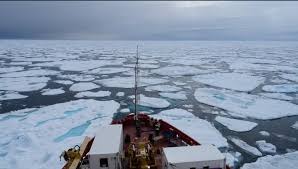The Arctic, once a zone of cooperation, is now a geopolitical flashpoint as melting ice unlocks resources, trade routes, and sparks rivalry among global superpowers.
LONDON: The Arctic is huge, covering almost 4 percent of the globe, and is now a focal point in the global rush for resources. It’s also a place where a new battleground is emerging, with the world’s superpowers gearing up to take each other on in a mad dash for control and strategic superiority. As the Arctic region undergoes unprecedented changes due to climate change, the melting of the ice is opening up a world of possibilities and the big powers know it – and they’re hungry for it. As the Arctic contains about 30 percent of the world’s natural gas supplies and 15 percent of oil, not to mention all those metals and rare earths, a huge treasure trove of previously untapped natural resources awaits. New trade routes are also opening up with more planned. On a visit to Norway and Iceland last week David Lammy, Britain’s foreign secretary, summed it all up: “The Arctic is fast becoming an area of intense focus for geopolitical competition and a key flank of NATO’s defences,” he told reporters. “Russia has been building up its military presence here for years. As the ice in the region melts, new shipping routes and resources will be exposed, further heightening the risk of confrontation. That’s why we must action to deter threats in the region.”
But it hasn’t always been like this. Back in 1987, the Soviet Union’s Mikhail Gorbachev launched a series of policy initiatives aimed at lowering the level of military confrontation in the Arctic by creating cooperation among the eight Arctic states: Canada, Denmark (via Greenland), Finland, Iceland, Norway, Sweden, Russia and the United States. This gave birth to a new strategic environment in the region – an “Arctic Exceptionalism”, that until recent years endured in part because these countries share common regional interests. Their interactions were supported by a range of robust institutional frameworks, from the Arctic Council to the Barents Euro-Arctic Council. Following Vladimir Putin’s decision to invade Ukraine, however, all scientific cooperation with Russia was discontinued and in March 2022 the Arctic Council’s work was paused. Pessimism about its future increased when President Donald Trump launched his own attack on science through mass firings, cuts in funding, and limitations to research and education.
Following Russia’s full-scale invasion of Ukraine, two of the Arctic countries, Sweden and Finland, applied to join NATO as a way of protecting themselves from potential Russian aggression. So now seven of the Arctic states are NATO members, which has led to sharp uplift in geopolitical tensions between Russia and the others. Russia, however, is still the dominant power in the region, both in terms of geography and resources – its Arctic coastline of 24,140km spans more than half of the total. The Kremlin has been pouring assets into the region in recent years, such as nuclear icebreakers, new ports and research stations, all seen as essential for Russia’s security and economic interests in promoting itself as a great power. Since 2013, for example, Moscow has reopened or built more than a dozen Arctic military bases, including key sites such as Franz Josef Land, Novaya Zemlya and other Siberian islands, all supporting air, land and sea operations. The new or reconstructed ports of Tiksi, Dikson, Pevek and Sabetta, in addition to the long-established Murmansk and Archangel, are all part of Russia’s Northern Sea Route (NSR) project, aimed at boosting trade and creating new economic opportunities. Much of this infrastructure redevelopment is financed by China, which also provides Russia with technology and expertise.
This NSR, known as Russia’s ‘Arctic Silk Road’, is crucial to both Moscow and Beijing as it offers the potential to shorten transit times between Europe and Asia. The journey from Asia to Europe will be just 19 days, far shorter than the 48 days it normally takes ships to go from China to Europe’s largest port in Rotterdam. Without doubt, the most impressive infrastructure Russia is currently building is the megaport on the Arctic Taymyr peninsula, formerly frozen for nine months of the year and now less than six. Dubbed the biggest project in the modern-day global oil industry, this $110BN facility will house Russia’s largest Arctic oil terminal and is so huge and so remote that the state-owned oil company Rosneft is having to build extensive infrastructure just to get to the site. New highways, two airports, 15 villages and several electricity plants are being developed to get the construction off the ground and house the 400,000 workers that are needed to make it all happen. Russia is also building a 770km pipeline to transport oil to the port, where 10 new ice-class tankers will take it on the remainder of its journey to Europe and Asia.
China also has long-term plans to become a polar superpower and has declared itself a ‘near-Arctic’ state, even though its northernmost regional capital is on the same latitude as Italy’s Venice! Beijing first positioned itself in the Arctic more than 20 years ago when it established a scientific research facility, the Yellow River Station, deep inside the Arctic circle on Norway’s Svalbard archipelago, one of the world’s northernmost inhabited areas. Only 500 miles from the north pole, Svalbard has 24-hrs of daylight in summer and zero in winter! It’s also a hotspot microcosm of geopolitical tensions. The archipelago is Norwegian, but is governed by a treaty allowing people from all countries assigned to it to work visa free, mainly in mines and scientific research. Svalbard is harmonious in theory, but since Russia’s full-scale invasion of Ukraine there’s been a noticeable flexing of nationalistic muscle. Military parades have taken place in the Russian settlement and there’s a growing suspicion that the Chinese have made their research station dual purpose for military espionage.
Deeply suspicious of China’s intentions, the European Arctic is beginning to reject China’s ‘purchase-your-way-into-the-Arctic’ approach, as Beijing discovered when it tried to buy seaports from Norway and Sweden. China’s offer to buy an airport in Greenland was also turned down. Andreas Osthagen, a senior fellow at the independent Fridjof Nansen Institute in Lysaker Norway, describes the Arctic as ‘low-hanging fruit’ for Russia-Chinese collaboration. “Russia needs investments and commercial actors who are interested in developing the Arctic LNG resources, or developing a northern sea route as a shipping lane”, he told the BBC last week. “China is that market. The two countries are looking for ways to expand their political, economic, and even military cooperation”.
Before its full-scale invasion of Ukraine, Russia actually tried to limit China from extending its superior military-industrial capability and scale into the Arctic, and even worked within the Arctic Council to help keep China in check. Putin’s aggression changed all that. The reeling Russian economy is growing more dependent on the Chinese industrial, technological and financial power and Moscow is now Beijing’s junior partner. Xi Jinping is also taking advantage of Russia’s isolation to gain more opportunities to exploit Russia’s extensive Arctic coastline, absorb its energy and mineral resources, develop its polar science and technological capabilities, and expand its military reach. As a result, China now strongly supports Russia’s Arctic ambitions, diplomatically and economically, creating a strategic partnership to counterbalance Western influence in the region.
The US is desperately trying to catch up in the region, having closed down numerous bases and curtailed its military operations in the Arctic after the Cold War. Much of its infrastructure was neglected over the years and nowadays it struggles to keep even one heavy icebreaker afloat, by comparison with China’s three and Russia’s forty. In 2021, the US and Canada agreed to give new life to their joint North American Aerospace Defence Command in order to counterbalance the mounting threat from Russia and China.
Inevitably, Donald Trump has waded into the argument with his fixation on Greenland, where the US keeps forces operating out of the Thule Air Base. This northernmost US asset plays a critical role in early missile warning and space surveillance. An autonomous territory within the Kingdom of Denmark, Greenland’s location between North America and Europe makes it strategically important. Trump’s obsession is all about obtaining a “counterbalance” to the growing collaboration between the US’s most consequential adversaries, Russia and China. “You have Russian ships all over the place,” he said in an interview recently. “They are sailing all over Canada, they are sailing right next to Greenland. We’re not going to let that happen”. Trump’s interest in Greenland became widely known in 2019 when reports surfaced that he wanted to buy the world’s largest island from Denmark, the idea he reactivated in Trump 2.0, which Denmark quickly rejected.
With rivalry for resources, vital shipping lanes and military supremacy, the Arctic is quickly changing into a disputed geopolitical region. In the absence of defined methods to handle these tensions, the region runs the risk of turning into a hot spot for future hostilities. These are times of big power politics and countries increasingly act in their own interests. With so many rival nations now in the Arctic, the risks of miscalculation or misinterpretation are high. Arctic Exceptionalism is clearly dead.








